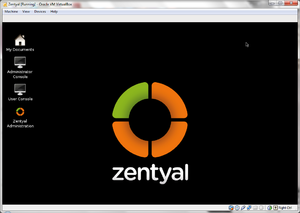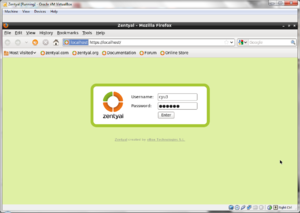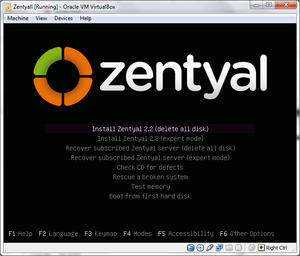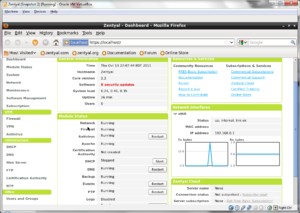COMP 3000 2011 Report: Zentyal: Difference between revisions
| Line 35: | Line 35: | ||
;Virtual disk file location and size | ;Virtual disk file location and size | ||
: The default setting is fine | : The default setting is fine | ||
[[File:Boot_from_cd.png|thumb|Devices > CD/DVD Devices > Choose a virtual CD/DVD disk file...]] | |||
When everything is all set up, it should now display the Summary of your virtual machine's specifications. | When everything is all set up, it should now display the Summary of your virtual machine's specifications. | ||
| Line 40: | Line 42: | ||
After you have successfully created your virtual machine, power it on by double clicking on the name of your virtual machine (in this case, Zentyal). The first time you power on your virtual machine, it will ask you how you want to boot up. You would want to boot up the Zentyal OS file (disk image) that you downloaded from the site. | After you have successfully created your virtual machine, power it on by double clicking on the name of your virtual machine (in this case, Zentyal). The first time you power on your virtual machine, it will ask you how you want to boot up. You would want to boot up the Zentyal OS file (disk image) that you downloaded from the site. | ||
If for some reason, you aren't prompt for the .iso file, you can mount the file using Virtualbox manually. You can do this by | |||
After you have selected your disk image to boot, restart your virtual machine. It will automatically boot your Zentyal disk image and prompt you to choose a language. Afterwards, the boot menu will be displayed. | |||
[[File:zentyal_boot_menu.png|thumb]] | [[File:zentyal_boot_menu.png|thumb]] | ||
You have two options for installation: | <br>You have two options for installation: | ||
;Install Zentyal (delete all disk) | ;Install Zentyal (delete all disk) | ||
: This is the default mode, it deletes all disk contents and creates the partitions required by Zentyal | : This is the default mode, it deletes all disk contents and creates the partitions required by Zentyal | ||
Revision as of 23:47, 16 October 2011
Part 1
Background

Zentyal was formerly known as the eBox Platform since it was developed by eBox Technologies. It's an open source unified network server software package (or a unified network platform). It includes development framework to ease development of new Unix based services. It is targeted at network administrators as it offers easy and efficient computer network administration for small and medium sized businesses because Zentyal can provide various networking services such as a gateway, network infrastructure manager, unified threat manager, office server or unified communications server or a combination of them.
The operating system can be obtained from the official site (zentyal.org) for free of charge. It is 625,224KB big in a disk image format.
Installation/Startup
For the purpose of this report, Zentyal is installed on a virtual machine using VirtualBox (VirtualBox). The disk image can be downloaded from the official site of the Linux OS (Zentyal).
VirtualBox setup


After you've downloaded Zentyal's disk image, a virtual machine needs to be created with appropriate settings. The configurations for my virtual machine were mainly default:
- Welcome page
- Nothing needed to be done here
- VM name and OS type
- Name: Zentyal
- Operating System: Linux
- Version: Other linux
- Memory
- 256MB
- Virtual Hard Disk
- Have the start up disk checked then create new hard disk
- Welcome to virtual disk creation wizard
- select VDI
- Virtual disk storage details
- Dynamically allocated
- Virtual disk file location and size
- The default setting is fine

When everything is all set up, it should now display the Summary of your virtual machine's specifications.
After you have successfully created your virtual machine, power it on by double clicking on the name of your virtual machine (in this case, Zentyal). The first time you power on your virtual machine, it will ask you how you want to boot up. You would want to boot up the Zentyal OS file (disk image) that you downloaded from the site.
If for some reason, you aren't prompt for the .iso file, you can mount the file using Virtualbox manually. You can do this by
After you have selected your disk image to boot, restart your virtual machine. It will automatically boot your Zentyal disk image and prompt you to choose a language. Afterwards, the boot menu will be displayed.

You have two options for installation:
- Install Zentyal (delete all disk)
- This is the default mode, it deletes all disk contents and creates the partitions required by Zentyal
- Install Zentyal (expert mode)
- This option allows customized partitioning
I installed Zenyal using the default mode then went through the installation process.
When you've finished installing the OS onto your virtual machine, it will automatically run Firefox, this is the Graphical User Interface that allows you to have network administrative access. You can configure settings, install modules and monitor network activities using the GUI.
Basic Operation

Zentyal can be used as either a gateway and firewall for internet connection or a server for a small or medium sized network that either provides local or internet services.
After starting up Zentyal for the first time, it will automatically start up a web administration interface that will require you to put in credentials. Both the username and password are the same as the ones you put in during the installation process.
You will find that there aren't that many functionality when you first start up the OS. After you have put in the correct credentials, you can then install modules to create servers or manage and configure networking activities. If you have trouble with which modules to install, there's an option to view specific functions that packages up the modules for easy installation. Afterward a successful installation, you will be guided to a first time configuration wizard which walks you through the process of either setting up a server for a chat room or connecting to a network to view networking activities within the local area network.
Usage Evaluation
This is a good Linux Distribution for network management.
References
http://www.distrowatch.com/table.php?distribution=zentyal. Retrieved 2011-10-12
http://www.zentyal.org/. Retrieved 2011-10-12
http://www.howtoforge.com/zentyal-as-a-gateway-the-perfect-setup. Retrieved 2011-10-13
http://www.unix-tutorials.com/go.php?id=4510. Retrieved 2011-10-15
http://www.unix-tutorials.com/go.php?id=4237. Retrieved 2011-10-15